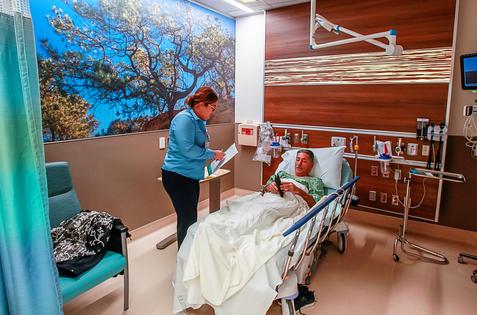UC San Diego opens new senior-focused emergency unit
Published in Senior Living Features
There's no sign notifying patients that they are entering the new Gary and Mary West Senior Emergency Care Unit, but it's immediately obvious that something has changed.
Moving from the main emergency department at UC San Diego's Jacobs Medical Center into the corridor that leads to the new unit, there is a noticeable drop in noise level and visitors are soon greeted by a wall-sized, full-color photograph of Torrey Pines State Beach.
Walls are painted in a contrasting two-tone color scheme. The lighting is softer with a variable intensity indexed electronically to the time of day outside.
The unit's 11 exam rooms continue the design theme with large local beach photos consuming a full wall of each single-occupant suite. In addition to beds, there are thickly-padded chairs that look like medical recliners and are capable of elevating their occupants to standing position or lowering them to take a load off.
Overall, the feel is slightly upscale, like this is the unit around the corner for the VIPs that the regular folks never get to know about.
But admission to this tucked-away wing has nothing to do with who you know.
Age is the main criteria for landing one of these rooms. Beds are reserved for those age 65 and older. Answers to a series of five questions designed to gauge likelihood memory loss, fall risk and other geriatric issues also play into who gets escorted back and who stays in the main emergency department.
On a recent morning, Frank Staffiero of San Diego was resting in one of the unit's beds. As a former UCSD financial services employee, the 68-year-old said he knows what Thornton's old emergency room was like and quickly picked up on the differences in the new space.
"This just is a lot friendlier to the eye, a lot quieter," Staffiero said. "It doesn't look like it's in a hospital. It looks like we're in a nice office building."
Built in the empty space created when Thornton Hospital's medical testing laboratory moved to adjacent Jacobs, the unit is funded by a $12 million grant from the Gary and Mary West Foundation.
The remodeled exam room is the physical manifestation of a fundamental change in hospital protocol for seniors that started with staff retraining two years ago.
Nurses, doctors, technicians and social workers began taking a more holistic approach to the emergencies that bring seniors to the hospital, making sure that each patient gets a broader assessment, asking questions such as "have you fallen in the last month?" or "when was your last meal?" or "have you missed any medications?"
Memory screenings also became more common, and staff has been giving more priority to addressing any outside-the-hospital issues that screenings detect, said Dr. Ted Chan, chair of the university's Department of Emergency Medicine.
"Five, 10 years ago, we trained all of our staff and our residents to take care of acute problems and primary care has to take care of the rest. A unit like this, even though we've had processes in place for a couple of years now, makes it higher in everyone's mind that we're taking a more comprehensive approach with seniors," Chan said.
Already, before the unit opened on Jan. 2, the new approach has been getting demonstrable results, said Dr. Zia Agha, West Health's chief medical officer. He said Jacobs Medical Center has seen a significant decrease in the number of seniors who are admitted for expensive overnight stays.
"It's in the range of a 25 percent reduction," Agha said. "We're also looking at what that means in terms of cost."
West didn't fund the unit purely to do something nice for local seniors. The protocols used to run senior emergency services are designed to yield data that can help West quantify how much the design features incorporated in the remodel help reduce harmful and expensive factors such as falls and repeated return visits. Being able to prove benefit empirically, Agha said, could go a long way in getting other hospitals across the nation to take similar steps.
While having quieter surroundings, better lighting, more soothing decor and special non-skid floors might seem to some like window dressing, registered nurse Thomas Crimson, a central figure in the hospital's geriatric nursing initiative, said those features are real tools he uses every day.
Sound proofing built into walls, ceilings and even the large pictures throughout the unit, for example, isn't just about giving seniors a more peaceful stay. These features, he said, are quite functional.
"When a patient's hard of hearing, they need the quiet so they can hear you better," Crimson said. "Things like being able to eat in peace, having larger screens and better lighting, these things all figure in to getting the right diagnosis and a good understanding of what they're going to need after they go home."
Environment is especially important, Chan said, when memory loss is involved. Patients are much more sensitive to noisy environments and bright lights. Having high-contrast walls and seating makes falls during routine walking tests often performed in the emergency department less likely.
"Our architect team really looked into what's really best out there for seniors? What's soothing? What will keep them oriented and prevent them from becoming delirious or confused?" Chan said.
Though it opened on Jan. 2 with 11 beds, another eight exam rooms will be added to further expand the unit's capacity. The unit is just the third level-one senior emergency room in the United States to be certified by the American College of Emergency Physicians and the only one on the West Coast.
(c)2019 The San Diego Union-Tribune
Visit The San Diego Union-Tribune at www.sandiegouniontribune.com
Distributed by Tribune Content Agency, LLC.







Comments